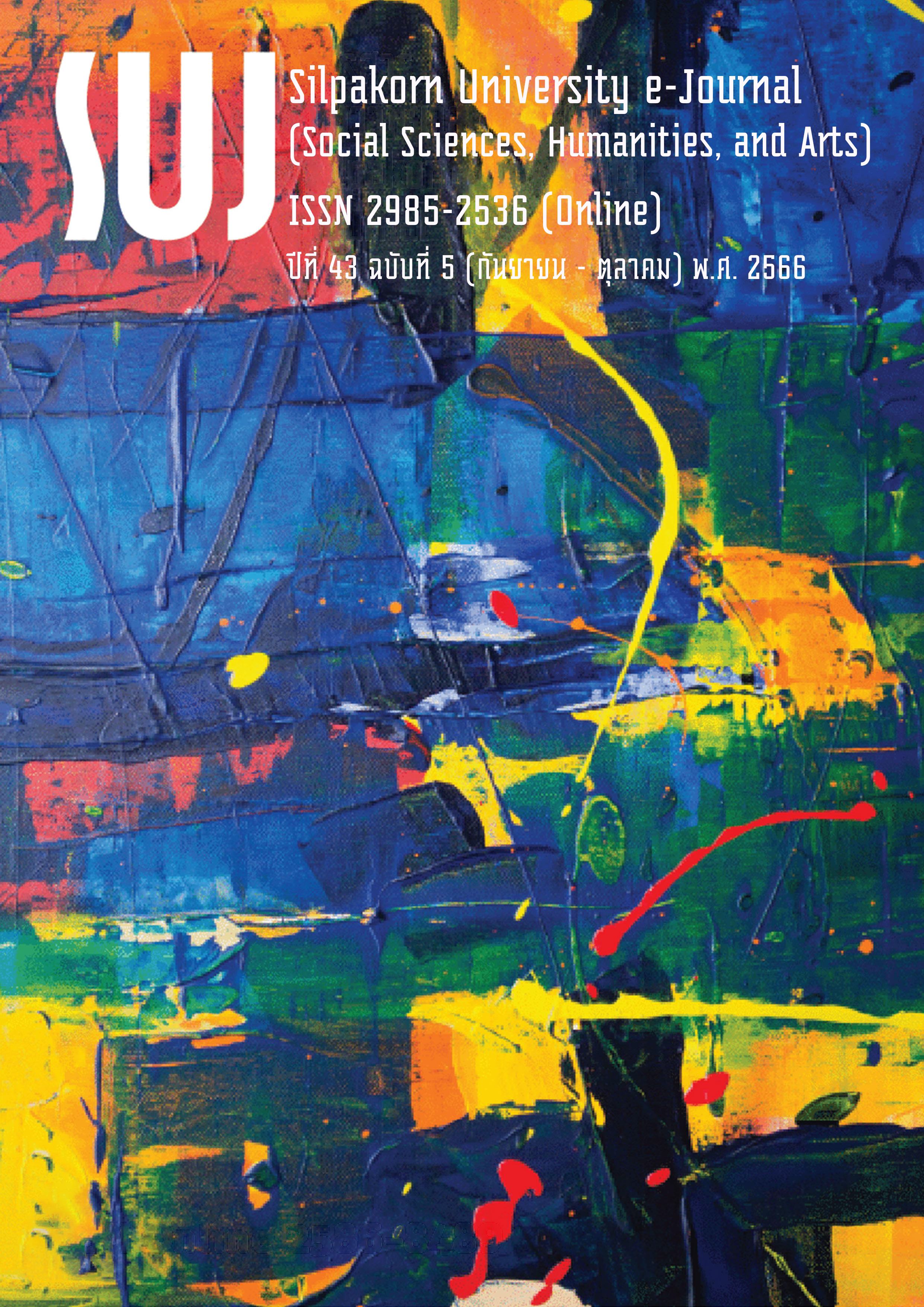ศิลปะผ้าทอลายดอกปีบสู่การสร้างสรรค์เสื้อผ้าเครื่องแต่งกายสตรี (The art of weaving flower-patterned silk cloth into creative women's clothing)
Main Article Content
Abstract
การวิจัยครั้งนี้เป็นการวิจัยและพัฒนา โดยมีวัตถุประสงค์เพื่อ 1) ศึกษาและวิเคราะห์ศิลปะการทอผ้าลายดอกปีบ 2) ออกแบบและสร้างสรรค์เสื้อผ้าเครื่องแต่งกายสตรีจากผ้าทอลายดอกปีบ สำหรับกลุ่มสตรีวัยทำงาน อายุ 25-45 ปี โดยประยุกต์ใช้องค์ความรู้ของผ้าทอ ศิลปะผ้าทอลายดอกปีบ หลักการออกแบบเสื้อผ้าเครื่องแต่งกาย และการออกแบบแฟชั่นยั่งยืนมาเป็นแนวทางด้วยการเน้นใช้ผ้าเป็นวัสดุหลัก ลดการใช้วัสดุชนิดอื่น ๆ ใช้การต่อผ้าเพื่อใช้ประโยชน์จากผ้าทอทั้งผืน ลดเศษผ้าเหลือทิ้ง ใช้เทคนิคการจีบระบาย และ 3) ประเมินผลการสร้างสรรค์เสื้อผ้าเครื่องแต่งกายสตรีจากผ้าทอลายดอกปีบร่วมกับช่างผู้เชี่ยวชาญในการตัดเย็บเสื้อผ้า ใน 2 องค์ประกอบ คือ องค์ประกอบของหลักการแนวคิดและองค์ประกอบของผลิตภัณฑ์ต้นแบบที่ได้ ผลการวิจัยพบว่า ความเป็นมาของผ้าทอลายดอกปีบได้รับแรงบันดาลใจจากดอกปีบ พันธุ์ไม้มงคลพระราชทานของจังหวัดพิษณุโลก โดยใช้เส้นฝ้ายหรือเส้นไหมประดิษฐ์ในการทอด้วยเทคนิคการมัดหมี่แบบเส้นพุ่ง ลวดลายของผ้าทั้งผืนแบ่งเป็น 3 ส่วน ส่วนแรกเป็นสีพื้น เช่น สีม่วง สีเหลือง สีฟ้า สีชมพู สีแดง ส่วนที่สองเป็นลายเชิง และส่วนที่สามเป็นตัวลายดอกปีบ ในส่วนนี้จะใช้เส้นใยสีขาว และผลการสร้างสรรค์เสื้อผ้าเครื่องแต่งกายต้นแบบ 1 คอลเลกชัน จำนวน 10 ชุด ประกอบด้วย ชุดเดรส ชุดกระโปรง ชุดกางเกง โดยใช้หลักศิลปะมาเป็นแนวทางในการออกแบบ ทำให้ชุดที่ได้มีความสวยงาม การตัดเย็บประณีต มีจุดเด่นจากการตกแต่งด้วยเทคนิคจีบระบาย รูปแบบสามารถนำเสนอให้ลวดลายทอของผ้าดอกปีบมีความโดดเด่น เครื่องแต่งกายสามารถประยุกต์ใช้ได้หลากหลายโอกาสการประเมินการสร้างสรรค์เสื้อผ้าเครื่องแต่งกายจากผ้าทอลายดอกปีบ พบว่า เป็นกระบวนการที่เหมาะสม เนื่องจากผลงานที่ได้สวมใส่ได้จริงและสามารถนำเสนอคุณสมบัติศิลปะของผ้าทอสู่การนำไปใช้ประโยชน์ได้จริง
The objectives of this study were: 1) To study and analyze the art of weaving flower-patterned silk cloth, “Dok Peep” fabric; 2) To design and create women’s clothing from the woven “Dok Peep” flower-patterned fabric for working-age women aged 25-45 years. The study applied knowledge of weaving, the art of weaving “Dok Peep” flower patterns, clothing design principles, and sustainable fashion design principles. The emphasis was on utilizing fabrics as the primary material, reducing the use of other materials, maximizing the utility of woven fabric, minimizing fabric waste, employing pleating techniques; and 3) To assess the feasibility of creating women’s clothing using “Dok Peep” flower pattern woven with cotton threads or artificial silk, collaborating with expert tailors. The evaluation included a performance appraisal form covering two elements: the conceptual element and the components of the prototype product achieved. The research findings revealed that the inspiration for weaving “Dok Peep” flower-patterned fabric was derived from the auspicious “Dok Peep” plants bestowed by royalty in Phitsanulok Province. The fabric was woven using silk or synthetic fibers, employing a weft-style Mudmee technique known as “Sen Phung” (upright thread). The fabric’s pattern was divided into three parts: the base color section (e.g., purple, yellow, blue, pink, and red), the decorative pattern section, and the “Dok Peep” flower pattern using white threads. The creation of the prototype clothing collection resulted in 10 sets, including dresses, skirts, and pants. The garments are remarkable with impeccable tailoring and distinctive pleated decoration techniques showcasing the signature woven “Dok Peep” flower pattern. The apparel is versatile for various occasions (mix and match). This approach proved suitable for creating clothing and apparel from woven fabric with a “Dok Peep” flower pattern, given its wearable nature. It effectively presents the artistic features of woven materials in practical applications.
Downloads
Article Details

This work is licensed under a Creative Commons Attribution-NonCommercial-NoDerivatives 4.0 International License.
References
Chawalawan, Jitrapee. (2012). Apparel Design and Scketch (การออกแบบเครื่องแต่งกายสมัยใหม่). Bangkok: Odeon Store.
Chudhavipata, Wattana. (2012). Textile: Reflection of Thai Traditions (ผ้าทอกับชีวิตคนไทย). Bangkok: Dhurakij Pundit University.
Jitchinakul, Khanitta. (2009). Local Textile Patterns: From Household to Business Sections (พัฒนาการลวดลายผ้าพื้นเมืองจากครัวเรือนสู่ภาคธุรกิจ). [Online]. Retrieved September 15, 2021 from https://scholar.utcc.ac.th/server/api/core/bitstreams/dfcde5fc-b67f-4e4a-812a-9507d84bf016/content
Phanichphant, Vithi. (2004). Thai Fabrics and Knitwear (ผ้าและสิ่งถักทอไท). Chiang Mai: Silkworm Books.
Phayakprakhon, Maywadee. (2017). Design and Development of Hol Pattern to Contemporary Design (การออกแบบพัฒนาลวดลายผ้าไหมโฮลเปราะแบบร่วมสมัย). Paper presented at the Conference on Wisdom to the Future, Khon Kaen. June 15-16.
Pumahapinyo, Siripen. (2020). Pattern graphic design of printed fabric to present the identity of Phetchaburi Karen’s woven fabric (การออกแบบลวดลายเรขศิลป์ผ้าพิมพ์ลายจากอัตลักษณ์ผ้าทอกะเหรี่ยง อำเภอหนองหญ้าปล้อง จังหวัดเพชรบุรี). Journal of Humanities and Social Sciences Review, 22(2): 100-121.
Rahman, O., & Kharb, D. (2018). Fashion innovativeness in India: Shopping behaviour, clothing evaluation and fashion information sources. International Journal of Fashion Design, Technology and Education, 11(3): 287-298.
Rattanaphaisankit, Rawit, Lerttevasiri, Pornthep, & Phrompan, Intira. (2021). A learning management guideline based on design thinking process for creating local product (แนวทางการจัดการเรียนรู้ตามกระบวนการคิดเชิงออกแบบเพื่อการสร้างสรรค์ผลิตภัณฑ์ท้องถิ่น). Fine Arts Journal: Srinakharinwirot University, 25(1): 119-136.
Saengnamphet, Thawatchai. (2017). Lines (เส้นสายลายเส้น). Bangkok: Odeon Store.
Sarobol, Atchara. (2018). Fashion Design and Application (การออกแบบเสื้อผ้า มิติทางวิชาการสู่การประยุกต์ใช้). Chiang Mai: Research Administration Center, Chiang Mai University.
Siripant, Sakda. (2016). Colour in Art, Culture, Science & Industry (สีในศิลปวัฒนธรรม วิทยาศาสตร์และอุตสาหกรรม). Bangkok: Amarin Printting and Publishing.
Sornnoey, Keeratiya. (2011). Fashion Design (การวาดภาพแฟชั่นและการออกแบบเสื้อผ้า). Bangkok: Wadsilp.
Srikaew, Thapanee, & Theppituck, Tatiya. (2017). Design of female apparel for the green consumer (การออกแบบเครื่องแต่งกายสตรีสำหรับผู้บริโภคสีเขียว). Art and Architecture Journal Naresuan University, 8(1): 125-141.
Srisuwan, Preeda, & Utiswannakul, Patcha. (2019). The creation of sustainable fashion (การออกแบบแฟชั่นยั่งยืน). Veridian E-Journal, Silpakorn University (Humanities, Social Sciences and Arts), 12(5): 711-728.


